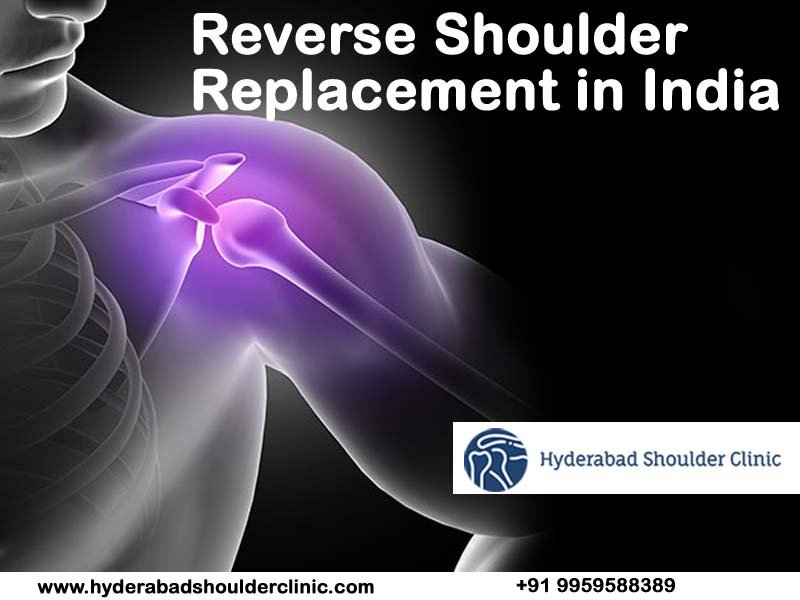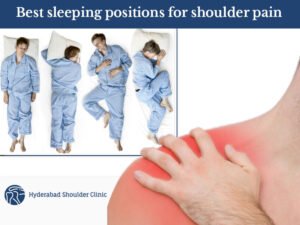The main difference between a standard shoulder replacement and the reverse procedure is that the natural positions of the shoulder, the ball parts and the socket are reversed. Full reverse shoulder replacement is a complicated procedure and is guaranteed under certain conditions. Call to schedule an appointment with Dr Chandra Shekar, shoulder surgeon experts, if you have shoulder problems that may require a shoulder replacement.
Our shoulders are among the most common joints in our body and are also complex due to their 360-degree mobility function. In contrast to our knee or ankle joints, our shoulder joints are used for many functions. Patients may require shoulder replacement surgery or shoulder arthroscopy surgery due to wear or trauma or osteoarthritis. Please find out more about shoulder replacement surgery in India and other useful information about it.
What is a “reverse” prosthesis?

Shoulder replacement is used to remove the arthritic part of the shoulder joint (missing cartilage). The shoulder joint is a ball and socket with a ball (or head of the shoulder) that forms part of the humerus and a flat surface (called a socket) that forms part of the shoulder blades. In a standard shoulder replacement, the round part of the shoulder (humeral head) is replaced with a metal ball and the socket with a plastic part.
With a “reverse prosthesis”, the shoulder joint is still replaced by metal and plastic parts or components. In this reversed prosthesis, the ball is placed on the side of the socket joint which is opposite to its natural position. The socket is then placed on the side of the arm, which is supported by a metal rod on the shoulder blade (humerus). So the ball and its socket are reversed.
How do they stay together?

Fortunately, the inverted prosthesis can be placed on the side of the base with screws
that secure it to the scapular bone. The ball is then screwed onto the plate that is attached to the socket.
The prosthesis placed in the bone of the hand is fixed with cement, which binds the metal to the bone within minutes. The plastic socket is then pressed against the end of the stem, where it is securely fastened to the metal part. This will allow the base to rotate on the ball, allowing the shoulder to move again. The muscles around the shoulder also help hold the back prosthesis in place.
Why should someone have a reversed prosthesis and not a regular shoulder replacement?
A standard full shoulder replacement depends on whether the muscles and tendons around the shoulder joint are intact. A group of muscles holds the head of the upper arm bone in the relatively flat shoulder socket (glenoid). Each of these muscles has a tendon that attaches it to the bone. These muscles and their tendons are collectively known as the rotator cuff. Often, when this tendon is significantly torn and can no longer remain attached to the bone, the shoulder does not function normally. Loss of the rotator cuff can cause pain and loss of movement. Normal shoulder replacement will only be successful if this tendon is intact. In contrast, inverted prostheses are in situations where the rotator cuff is torn or malfunctioning.
What shoulder conditions require a common reverse shoulder replacement?

- The main reason for an inverted prosthesis is when there is arthritis in the shoulder joint, and the rotator cuff tendon is torn or missing. This is the most common surgical indication for patients considering this surgery. In this situation, this operation will provide significant pain relief for the patient and can also help with shoulder mobility. Although the range of motion may not be completely normal after the prosthesis is inverted, it will usually increase compared to the movement previously lost due to arthritis and pain.
- Another reason for a reverse prosthesis is when the rotator cuff tendon is torn, and you cannot raise the arm high enough to function. Usually, the shoulder does not hurt in this case, but the inability to raise the arm significantly affects its function in life. When the patient raises the arm, there is a bulge on the front of the shoulder, which is called anterior-superior migration or shoulder subluxation. In these cases, pain may or may not be a major factor in prosthesis reversal, but the main reason for replacement is to restore movement and function.
- The third most common reason for making a reverse prosthesis is that the shoulder is replaced previously and it failed . The patient still experiences pain and loss of movement. Sometimes shoulder replacement is done regularly if the rotator cuff is broken or the tendon is ruptured, and the shoulder continues to be sore. In this case, the surgery for reverse prosthesis is a little more complicated. This is because the more traditional shoulder replacement has to be removed during surgery, and the reverse prosthesis can be placed on the shoulder.
Other causes of an inverted prosthesis include multiple fractures in the shoulder area,
particularly those affecting the proximal humerus (arm bone), where the ball attaches
to the axis of the bone. In some cases, the bone breaks into pieces or the ball may break into pieces.
- The final reason for making the prosthesis inverted is a tumour in the proximal humerus, which involves the bone in the bone axis or the humerus’ ball.
How is a reverse shoulder replacement performed?
During the procedure: Surgeon:

Step 1: Make an incision in the front of the arm and the muscles and tendons are moved away from the joint. The bone in the upper arm is then removed from the socket.
Step 2: The surgeon cuts the humerus, and an artificial socket is attached to the humerus.
Step 3: The nest is also prepared, and an artificial ball is attached to the blade.
Step 4: A metal rod is inserted into the arm bone, and a plastic socket is attached to the top of the arm bone.
Step 5: After placing the artificial parts, the tendons and muscles are carefully returned to their normal positions.
What to Expect After Reverse Shoulder Replacement Surgery?

You will be in pain when you recover after normal surgery. But your initial shoulder pain needs fixing. After the surgery, your arm will be on to sling up for several weeks, and physical therapy exercises will be carried out while you are still in the hospital. The hospital stay may be for 1-2 days. However, you cannot use your hands for several weeks. You can return to light work in a few weeks.
The cost of reverse shoulder replacement in India at Dr Chandra Shekar is affordable.
What results can I expect from a full reverse shoulder replacement?
Reverse shoulder replacements are great for pain relief. Studies from Europe show that about 85-90% of patients who undergo this procedure get excellent pain relief. The level of pain relief depends largely on the reason for the procedure. The degree of pain relief in the revised case is slightly lower than in the first procedure, and it is believed that this is due to long-term scarring and damage.
The reverse prosthesis should also restore some range of motion to the shoulder, but the rate of return is as unpredictable as pain relief. Most patients can reach the top of their head without tilting the head. Most patients see an increase in movement in the other direction. Still, if their rotator cuff is torn completely, they may not see an increase in their ability to move away from the body (known as “external rotation”).
How can I get reverse surgery treatment services in India?
Treatment potential is only possible with the best shoulder replacement surgeons in India, like Dr Chandra Shekar, who is specialized in affordable shoulder replacement surgery. We work with clinics that are equipped and compatible with complex shoulder surgeries. Not all surgeons can perform advanced shoulder surgery in India. Therefore, treatment is only possible with the best shoulder surgeons in India who are experienced in complex shoulder replacement operations and who can ensure the success of the operation.
The potential treatment should enable high-quality shoulder replacement surgery in India while ensuring the lowest medical benefits and surgery costs, especially for reverse shoulder replacement surgery. Our understanding of the Indian medical and healthcare market and our valuable relationship with the best shoulder replacement surgeons allow us to offer treatment at a reasonable price, affordable and transparent.
The results of the shoulder replacement surgery that Dr Chandra Shekar have performed in India have been mostly positive. You must undergo all the tests determined based on your medical history so that the doctor can determine the right medical solution while keeping the cost of surgery down.
Conclusion:
Get a consultation with Dr Chandra Shekar shoulder replacement surgeons in India with seamless customisation of postoperative recovery care, medical trips and stays during medical treatment. For more valuable information about shoulder replacement surgery in India, call Dr Chandra Shekar at 91 9959588389 and get in touch with us.
You can also send your shoulder replacement surgery medical reports to us for free reviews and advice from India’s best shoulder replacement surgeons. Regardless of your state of health, you will always have good healthy options and the cost benefits of potential treatment.





